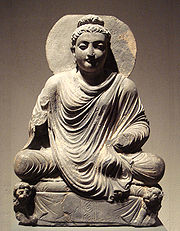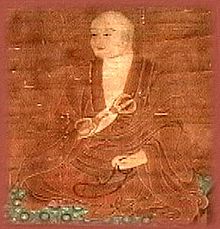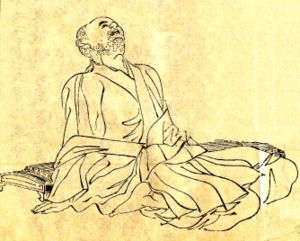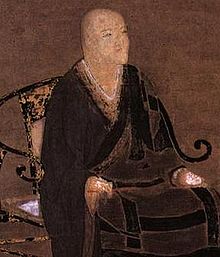
Buddhist poetry
Encyclopedia

,_late_19th-early_20th_century,_dhodeydrag_gonpa,_thimphu,_bhutan.jpg)








Genre
Genre , Greek: genos, γένος) is the term for any category of literature or other forms of art or culture, e.g. music, and in general, any type of discourse, whether written or spoken, audial or visual, based on some set of stylistic criteria. Genres are formed by conventions that change over time...
of literature
Buddhist texts
Buddhist texts can be categorized in a number of ways. The Western terms "scripture" and "canonical" are applied to Buddhism in inconsistent ways by Western scholars: for example, one authority refers to "scriptures and other canonical texts", while another says that scriptures can be categorized...
that forms a part of Buddhist
Buddhism
Buddhism is a religion and philosophy encompassing a variety of traditions, beliefs and practices, largely based on teachings attributed to Siddhartha Gautama, commonly known as the Buddha . The Buddha lived and taught in the northeastern Indian subcontinent some time between the 6th and 4th...
discourse
Discourse
Discourse generally refers to "written or spoken communication". The following are three more specific definitions:...
.
The first examples of Buddhist poetry can be found in traditional scriptures such as the Dhammapada
Dhammapada
The Dhammapada is a versified Buddhist scripture traditionally ascribed to the Buddha himself. It is one of the best-known texts from the Theravada canon....
, according to which, Siddhārtha Gautama (the founder of Buddhism), upon his reaching enlightenment, proclaimed:
Through the round of many births I roamed
without reward,
without rest,
seeking the house-builder.
Painful is birth
again & again.
House-builder, you're seen!
You will not build a house again.
All your rafters broken,
the ridge pole destroyed,
gone to the Unformed, the mind
has come to the end of craving.
Traditionally, most Buddhist sutras
Buddhist texts
Buddhist texts can be categorized in a number of ways. The Western terms "scripture" and "canonical" are applied to Buddhism in inconsistent ways by Western scholars: for example, one authority refers to "scriptures and other canonical texts", while another says that scriptures can be categorized...
have a prose component supplemented by verses (known as gatha) that reiterate and poetically summarize the themes of preceding prose passages. Gatha functions as a mnemonic
Mnemonic
A mnemonic , or mnemonic device, is any learning technique that aids memory. To improve long term memory, mnemonic systems are used to make memorization easier. Commonly encountered mnemonics are often verbal, such as a very short poem or a special word used to help a person remember something,...
device helping the Buddhist practitioner commit to memory a certain doctrinal maxim. And in fact, the earliest extant forms of Buddhist discourse appear in verse, which is hardly surprising, considering that the texts were not originally written, but memorized. Linguistic analysis shows that the prose component of the sutras is likely to have been modified by later editing, while the poems often contain earlier forms of language.
Current Buddhology
Buddhology
Buddhology is the study of the Buddha or Buddhahood. The term is also used as a synonym for Buddhist Studies, contemporary academic investigation of Buddhism....
generally maintains that even the liturgical
Liturgy
Liturgy is either the customary public worship done by a specific religious group, according to its particular traditions or a more precise term that distinguishes between those religious groups who believe their ritual requires the "people" to do the "work" of responding to the priest, and those...
scriptures are products of literary composition. Hence, the study of Buddhist text in general and Buddhist poetry in particular cannot be disengaged from the literary field. But for the sake of classification it is useful to distinguish between
- Buddhist poetry that is attributed to the Buddha himself, which forms a part of "Buddha Speech" (Sk. BuddhavacanaBuddhavacanaBuddhavacana, from Pali and Sanskrit, means "the Word of the Buddha." It refers to the works accepted within a tradition as being the teachings of the Buddha...
), and - Buddhist poetry written by Buddhists, which is not included in the sutras.
This article concerns primarily with the latter.
Buddhist poetry in Asia
A typical example of a Buddhist poet is Monk AśvaghoṣaAsvaghosa
' was an Indian philosopher-poet, born in Saketa in northern India to a Brahmin family. He is believed to have been the first Sanskrit dramatist, and is considered the greatest Indian poet prior to Kālidāsa. He was the most famous in a group of Buddhist court writers, whose epics rivaled the...
who used his poetic talent and education in Brahmanic
Historical Vedic religion
The religion of the Vedic period is a historical predecessor of Hinduism. Its liturgy is reflected in the mantra portion of the four Vedas, which are compiled in Sanskrit. The religious practices centered on a clergy administering rites...
tradition to compose poetry on various Buddhist themes, e.g. the life of the Buddha, the Buddhacarita
Buddhacarita
Buddhacharita is an epic poem in the Sanskrit mahakavya style on the life of Gautama Buddha by , composed in the 2nd century AD...
.
Buddhist poetry – like the bulk of the scriptures produced by Buddhists – is not limited to compositions in Pali
Páli
- External links :* *...
and Sanskrit
Sanskrit
Sanskrit , is a historical Indo-Aryan language and the primary liturgical language of Hinduism, Jainism and Buddhism.Buddhism: besides Pali, see Buddhist Hybrid Sanskrit Today, it is listed as one of the 22 scheduled languages of India and is an official language of the state of Uttarakhand...
; it has flourished in practically every language that Buddhists speak.
- Notable examples in the Tibetan tradition are works of MilarepaMilarepaJetsun Milarepa , is generally considered one of Tibet's most famous yogis and poets. He was a student of Marpa Lotsawa, and a major figure in the history of the Kagyu school of Tibetan Buddhism.- Life :...
. - Chinese Buddhist Tradition is particularly rich in poetic expression, e.g. Buddhist poems of Bai Juyi are quite famous. In Bai Juyi's poetry we see a tension between the secular and Buddhist poetic expression: many Buddhists considered poetry as an attachment and advocated against it, despite the fact that the scriptures revered by them were abundant in poetic forms. He is credited with the coinage of the expression kyōgen kigo (狂言綺語, lit. "deranged words and embellished language"), which, to his view, referred to futility of poetic expression in comparison to Buddhist practice. Perhaps, the most successful Chinese Buddhist poet to resolve this paradox was Jiao Ran 皎然 (730-799), who proposed treatment of poetry as an intellectual instrument of Buddhist practice.
- Korean poets wrote mostly in Classical ChineseClassical ChineseClassical Chinese or Literary Chinese is a traditional style of written Chinese based on the grammar and vocabulary of ancient Chinese, making it different from any modern spoken form of Chinese...
. - Japanese poets also contributed to Buddhist poetic tradition in classical Chinese (e.g. the poetic genius of KūkaiKukaiKūkai , also known posthumously as , 774–835, was a Japanese monk, civil servant, scholar, poet, and artist, founder of the Shingon or "True Word" school of Buddhism. Shingon followers usually refer to him by the honorific titles of and ....
inspired many poets of later generations.) Kūkai, in turn was influenced by Jiao Ran's Shi shi 詩式, as the latter is included in Kūkai's magnum opus of poetics, the Bunkyō hifuron 文鏡秘府論.
In medieval Japan
Japan
Japan is an island nation in East Asia. Located in the Pacific Ocean, it lies to the east of the Sea of Japan, China, North Korea, South Korea and Russia, stretching from the Sea of Okhotsk in the north to the East China Sea and Taiwan in the south...
, Buddhist poetry was accorded a special status of a separate genre within the corpus of the waka
Waka (poetry)
Waka or Yamato uta is a genre of classical Japanese verse and one of the major genres of Japanese literature...
collections.
Japanese Buddhist Poetry
1. The earliest extant collection of the Japanese poetry, the Man'yōshū, contains a preface (Jp. jo 序 or daishi 題詞) to two poems on the love of parents towards their children:"Sakyamuni expounds truthfully from his golden mouth, 'I love all things equally, the way I love my child, Rahula.' He also teaches that 'no love is greater than the love for ones child.' Even the greatest of saints cherishes his child. Who, then, among the living creatures of this world could fail to love children claimed as one's own?" There are several prefaces and poems in the Man'yōshū that mention the name of Buddha Śākyamuni (Jp. Shaka Nyorai 釋迦如来 /an honorific title of Siddhārtha Gautama), Buddhist temples (Jp. tera 寺), monks and nuns.
2. Among the treasures of Yakushi-ji
Yakushi-ji
is one of the most famous imperial and ancient Buddhist temples in Japan, located in Nara. The temple is the headquarters of the Hossō school of Japanese Buddhism...
Temple in Nara there are stone blocks dating from the Nara period
Nara period
The of the history of Japan covers the years from AD 710 to 794. Empress Gemmei established the capital of Heijō-kyō . Except for 5 years , when the capital was briefly moved again, it remained the capital of Japanese civilization until Emperor Kammu established a new capital, Nagaoka-kyō, in 784...
modeled as "the footsteps" of the Buddha (Jp. Bussokuseki 佛足石). These blocks contain poems in man'yōgana that may be considered the oldest Buddhist waka (Japanese language poems) known to date. These poems are usually referred to as bussokusekika
Bussokusekika
, also known as Bussokuseki no Uta, are poems inscribed beside the stone Buddha Foot monument at Yakushi Temple in Nara.Numbering twenty one poems in total, they are divided into two sections:*Seventeen poems praising the virtue of Buddha....
(lit. "poems on stone imprints of Buddha's feet": 仏足石歌). Consider the following example:
| Rōmaji | English |
|
|
Both examples above have one trait in common. Namely, the focus on the physical characteristics of the Buddha
Physical characteristics of the Buddha
The physical characteristics of the Buddha refers to the general appearance and characteristics of Gautama Buddha's physical body. There are no extant representations of the Buddha represented in artistic form until roughly the 2nd century CE, partly due to the prominence of aniconism in the...
is prominent: "the golden mouth" of the Buddha in the Man'yoshu and the "feet of the Buddha" in the stone inscriptions relate to the marks of perfection of the Buddha's body / speech (Skt. mahāpuruṣa, lit. [signs of] "a great person").
In the Heian period
Heian period
The is the last division of classical Japanese history, running from 794 to 1185. The period is named after the capital city of Heian-kyō, or modern Kyōto. It is the period in Japanese history when Buddhism, Taoism and other Chinese influences were at their height...
, Buddhist poetry began to be anthologized in the Imperial Anthologies (Jp. chokusenshū 勅選集. Among the 21 Imperial Anthologies, 19 contain Buddhist tanka
Waka (poetry)
Waka or Yamato uta is a genre of classical Japanese verse and one of the major genres of Japanese literature...
(lit. short waka) starting with the Shūi Wakashū, compiled between 1005 and 1007 C.E.
The first Imperial Anthology to treat Buddhist tanka as a separate genre, i.e. shakkyōka (lit. "Poems of Śākyamuni's Teaching": 釈教歌), is the Senzai Wakashū, which has an exclusive section dedicated to the Buddhist Poems in Volume 19 (第十九巻).
Among the most famous poets who wrote shakkyōka are:
Saigyō
Saigyo
was a famous Japanese poet of the late Heian and early Kamakura period.-Biography:Born Satō Norikiyo in Kyoto to a noble family, he lived during the traumatic transition of power between the old court nobles and the new samurai warriors. After the start of the Age of Mappō , Buddhism was...
;
Jakuren
Jakuren
' was a Japanese Buddhist priest and poet. He was adopted by the noted poet Fujiwara no Shunzei upon the death of Shunzei's younger brother...
;
Kamo no Chōmei
Kamo no Chomei
was a Japanese author, poet , and essayist. He witnessed a series of natural and social disasters, and, having lost his political backing, was passed over for promotion within the Shinto shrine associated with his family. He decided to turn his back on society, take Buddhist vows, and became a...
;
Fujiwara no Shunzei
Fujiwara no Shunzei
was a noted Japanese poet and nobleman, son of Fujiwara no Toshitada. He was also known as Fujiwara no Toshinari or Shakua ; in his younger days , he gave his name as Akihiro , but in 1167, changed to Shunzei...
;
Jien
Jien
Jien was a Japanese poet, historian, and Buddhist monk.-Biography:Jien was the son Fujiwara no Tadamichi, a member of the Fujiwara family of powerful aristocrats. He joined a Buddhist monastery of the Tendai sect early in his life, first taking the Buddhist name Dokaie, and later changing it to...
;
Nōin
Noin
Nōin 能因 . Japanese poet and monk of the late Heian period. Lay name: Tachibana no Nagayasu 橘永愷. Along with Izumi Shikibu, Nōin is one of "Thirty-six Medieval Poetry Immortals" of waka poetry selected by Fujiwara no Norikane 藤原範兼 ....
;
Dōgen
Dogen
Dōgen Zenji was a Japanese Zen Buddhist teacher born in Kyōto, and the founder of the Sōtō school of Zen in Japan after travelling to China and training under the Chinese Caodong lineage there...
, Ton'a
Ton'a
, also spelled as Tonna; lay name – Nikaidō Sadamune 二階堂貞宗. A Japanese Buddhist poet, student of Nijō Tameyo 二条為世. Ton'a took a tonsure at Enryaku-ji Temple, but was later associated with the Ji sect 時宗 . He looked up to Saigyō's poetic genius...
, etc. Many of the so-called "Thirty-six Poetry Immortals
Thirty-six Poetry Immortals
The Thirty-six Poetry Immortals are a group of Japanese poets of the Nara, Asuka and Heian periods selected by Fujiwara no Kintō as exemplars of Japanese poetic ability. There are five female poets among them...
" wrote Buddhist poetry.
Shakkyōka can be subdivided according to the ten following motifs:
- Buddhas and bodhisattvas;
- Eminent monks / nuns;
- A passage from a sutra;
- A passage from commentatorial corpus of the Buddhist canon;
- Buddhist Experience (meditative / devotional states);
- Mental states, such as delusion, passion, anger, etc. that are important in the Buddhist discourse;
- Religious deeds;
- Related to temples and shrines;
- Buddhist views of Nature;
- Natural phenomena alluding to Buddhist themes (e.g. transience of flowers blooming)
These motifs are not mutually exclusive and are very often combined within a given poem.
One of the most famous collections of Japanese tanka of the Kamakura period
Kamakura period
The is a period of Japanese history that marks the governance by the Kamakura Shogunate, officially established in 1192 in Kamakura by the first shogun Minamoto no Yoritomo....
, the Hyakunin Isshu
Hyakunin Isshu
is a traditional anthology style of compiling Japanese waka poetry where each contributor writes one poem for the anthology. Literally, it translates to "one hundred people, one poem [each]"...
contains several shakkyōka, for instance Poem 95, by Jien
Jien
Jien was a Japanese poet, historian, and Buddhist monk.-Biography:Jien was the son Fujiwara no Tadamichi, a member of the Fujiwara family of powerful aristocrats. He joined a Buddhist monastery of the Tendai sect early in his life, first taking the Buddhist name Dokaie, and later changing it to...
(also anthologized in the Senzai Wakashū: 巻十七, 雑中, No. 1137):
おほけなく
うき世の民に
おほふかな
わがたつそまに
墨染の袖
Unworthy though I am,
I cast my black robe of a monk
Upon this suffering world,
Living here
On the Mount of Timber.
In later periods, as tanka was slowly being overshadowed by renga
Renga
' is a genre of Japanese collaborative poetry. A renga consists of at least two or stanzas, usually many more. The opening stanza of the renga, called the , became the basis for the modern haiku form of poetry....
and haiku
Haiku
' , plural haiku, is a very short form of Japanese poetry typically characterised by three qualities:* The essence of haiku is "cutting"...
– the two poetic forms that derived from tanka – such famous poets as "the seven worthies of renga", (Jp. renga shichiken 連歌七賢) of the Muromachi period
Muromachi period
The is a division of Japanese history running from approximately 1336 to 1573. The period marks the governance of the Muromachi or Ashikaga shogunate, which was officially established in 1338 by the first Muromachi shogun, Ashikaga Takauji, two years after the brief Kemmu restoration of imperial...
, Sōgi
Sogi
was a Japanese poet. He came from a humble family from the province of Kii or Ōmi, and died in Hakone on September 1, 1502. Sōgi was a Zen monk from the Shokokuji temple in Kyoto and he studied poetry, both waka and renga...
, and still later, Matsuo Bashō
Matsuo Basho
, born , then , was the most famous poet of the Edo period in Japan. During his lifetime, Bashō was recognized for his works in the collaborative haikai no renga form; today, after centuries of commentary, he is recognized as a master of brief and clear haiku...
, Kobayashi Issa
Kobayashi Issa
, was a Japanese poet and lay Buddhist priest of the Jōdo Shinshū sect known for his haiku poems and journals. He is better known as simply , a pen name meaning Cup-of-tea...
, among many others, carried on the tradition of Buddhist poetry with their compositions.
菊の香や
奈良には古き
仏達
Kiku no ka ya
Nara ni wa furuki
Hotoketachi
In the city of Nara
Fragrance of chrysanthemums;
Buddhas of yore.
Bashō
The nostalgic feeling of the ancient capital, Nara
Nara, Nara
is the capital city of Nara Prefecture in the Kansai region of Japan. The city occupies the northern part of Nara Prefecture, directly bordering Kyoto Prefecture...
– interspersed with the scent of chrysanthemums (symbol of Japanese monarchy
Chrysanthemum Throne
The is the English term used to identify the throne of the Emperor of Japan. The term can refer to very specific seating, such as the takamikura throne in the Shishin-den at Kyoto Imperial Palace....
) and the old Buddha statues – captures well the aesthetic ideals of sabi
Wabi-sabi
represents a comprehensive Japanese world view or aesthetic centered on the acceptance of transience. The aesthetic is sometimes described as one of beauty that is "imperfect, impermanent, and incomplete"...
and yūgen in this famous haiku. Although these three lines appear to be a mere utterance of almost prosaic quality, the imagery invoked is far from simplistic. Buddhas, emperors, passage of time, the ethereal beauty of flowers that presents itself obliquely, i.e., appealing to scent rather than sight – all suggest that the poet sought to use language as a medium of condensed imagery to map an immediate experience, whose richness can only be read in the blanks.
露の世は露の世ながらさりながら
tsuyu no yo wa tsuyu no yo nagara sari nagara
This world of dew
is just a world of dew,
and yet...
Issa
Here the poet uses the image of evanescence of our world, the dewdrop – one of the classical allegories
Allegory
Allegory is a demonstrative form of representation explaining meaning other than the words that are spoken. Allegory communicates its message by means of symbolic figures, actions or symbolic representation...
of the Buddhist teaching – to express grief caused by the death of his daughter. In theory, Buddhism teaches its followers to regard all the vicissitudes of life as transitory and ephemeral, akin to magic apparitions without substance or dewdrops soon to evaporate under the sun. Yet, a father's loss of his child is more than reason can counter.
Buddhist poetry and modernity
As Japan reached the era of industrialized modernityModernity
Modernity typically refers to a post-traditional, post-medieval historical period, one marked by the move from feudalism toward capitalism, industrialization, secularization, rationalization, the nation-state and its constituent institutions and forms of surveillance...
, many of the poets of the Meiji period
Meiji period
The , also known as the Meiji era, is a Japanese era which extended from September 1868 through July 1912. This period represents the first half of the Empire of Japan.- Meiji Restoration and the emperor :...
started to experiment with the European styles of poetic composition. Some poets, notably Miyazawa Kenji – a devout Buddhist, who expressed his convictions in his poetry and fiction – often composed poems with Buddhist overtones. His Ame ni mo Makezu
Ame ni mo Makezu
Ame ni mo makezu is a famous poem written by Kenji Miyazawa, a poet from the northern prefecture of Iwate in Japan who lived from 1896 to 1933...
(雨ニモマケズ) is known to practically every Japanese today. Miyazawa Kenji revered the Lotus Sutra
Lotus Sutra
The Lotus Sūtra is one of the most popular and influential Mahāyāna sūtras, and the basis on which the Tiantai and Nichiren sects of Buddhism were established.-Title:...
妙法蓮華經 , which lent its theme to the poem (Chapter 14: Peaceful and Joyous Deeds / Jp. Anrakugyō 安楽行).
A Modern Indian Sanskrit poet, Vanikavi Dr. Manomohan Acharya wrote Sri Gautama Buddha Panchakam in simple and lucid Sanskrit through lyrical style. Ultimately, everyone who learns Japanese today would be familiar with the Iroha
Iroha
The is a Japanese poem, probably written in the Heian era . Originally the poem was attributed to the founder of the Shingon Esoteric sect of Buddhism in Japan, Kūkai, but more modern research has found the date of composition to be later in the Heian Period. The first record of its existence...
poem. Originally written in man'yōgana and attributed to Kūkai
Kukai
Kūkai , also known posthumously as , 774–835, was a Japanese monk, civil servant, scholar, poet, and artist, founder of the Shingon or "True Word" school of Buddhism. Shingon followers usually refer to him by the honorific titles of and ....
, this Buddhist poem contains every kana
Kana
Kana are the syllabic Japanese scripts, as opposed to the logographic Chinese characters known in Japan as kanji and the Roman alphabet known as rōmaji...
precisely once, and is learned in Japanese primary schools mainly for this reason. Many old-style Japanese dictionaries adhere to the Iroha order.
External links
- A Sketch of Buddha's Life: contains many of the early Pali poems.
- The Dhammapada, e.g Buddha's Enlightenment poem: 153-154.
- The Senzaishu in Japanese, cf. Vol 19, 釈教.
- Selected translations and an Introduction to Waka.
- Search Engine of the Man'yoshu in Japanese.
- A fan website on Miyazawa Kenji with translations of works.
- A Buddhist poetry fan site.
- Sacred Poetry from Around the World.
- jeromes niece A collection of poetry Dharma submitted by readers.

